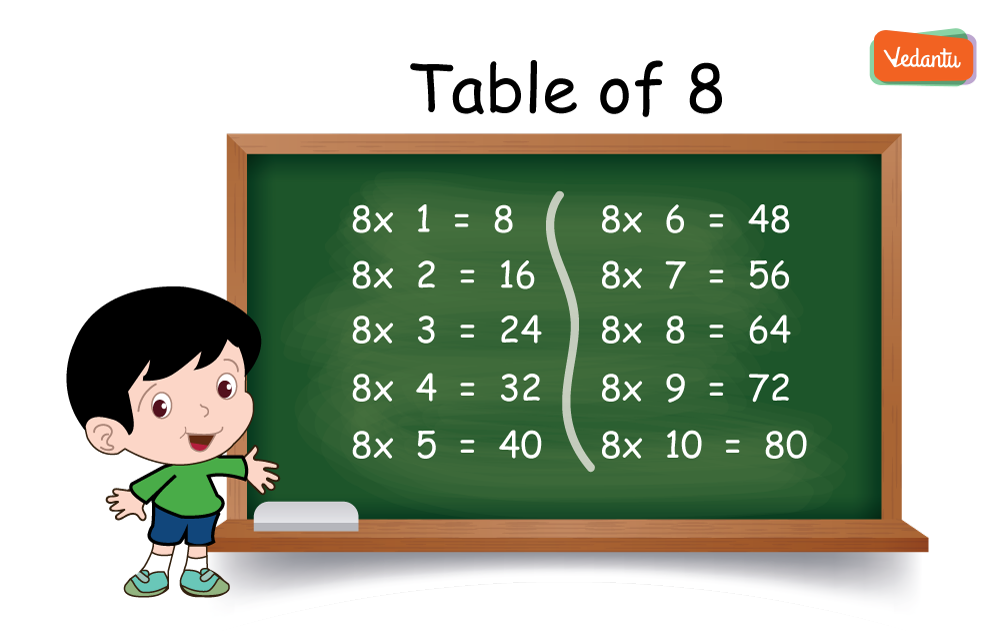How to Remember the Table of 8 Quickly and Effectively
FAQs on Table of 8: Multiplication Made Simple
1. What is the multiplication table of 8?
The multiplication table of 8, often called the 8 times table, is a list of the multiples of 8. It is generated by multiplying the number 8 by a sequence of natural numbers (1, 2, 3, and so on). Essentially, it's a way of showing repeated addition of the number 8. For example, 8 x 3 is the same as 8 + 8 + 8, which equals 24. Learning this table is a fundamental step in building strong calculation skills.
2. What is an easy trick to learn the 8 times table quickly?
A simple and popular trick to learn the 8 times table involves a pattern. Follow these steps:
Step 1: For the tens digit, write down the numbers 0, 1, 2, 3, 4. Then, repeat the 4 and continue with 5, 6, 7, 8. It will look like this: 0, 1, 2, 3, 4, 4, 5, 6, 7, 8.
Step 2: For the ones digit, start from 8 and count down by 2s: 8, 6, 4, 2, 0. Repeat this pattern again.
Step 3: Combine these numbers to get the full table: 08, 16, 24, 32, 40, 48, 56, 64, 72, 80.
3. How is the 8 times table related to the 2 and 4 times tables?
The 8 times table has a direct relationship with the 2 and 4 times tables, which can make it easier to understand. Multiplying a number by 8 is the same as doubling the result from the 4 times table. For example, to find 8 x 5, you can first calculate 4 x 5 = 20, and then double that result (20 x 2) to get 40. Similarly, multiplying by 8 is like doubling a number three times (multiplying by 2, then 2, then 2 again). For 8 x 6: 6 x 2 = 12, 12 x 2 = 24, and 24 x 2 = 48.
4. How can you quickly check if a large number is a multiple of 8?
To check if any large number is a multiple of 8 without performing long division, you only need to look at its last three digits. If the number formed by the last three digits is divisible by 8, then the entire number is divisible by 8. For example, to check the number 57,120: the last three digits are 120. Since 120 divided by 8 is 15, the entire number 57,120 is a multiple of 8. If a number is less than three digits, like 96, you would just divide the number itself by 8.
5. What is a real-life example of using the 8 times table?
The 8 times table is useful in many everyday situations. Imagine you are buying tickets for a Ferris wheel that has 8 seats in each car. If you want to know the total number of people that can ride in 6 cars, you would use the 8 times table. By calculating 8 seats x 6 cars, you find the answer is 48 people. This helps in planning, shopping for items that come in packs of 8 (like juice boxes or spider-shaped party favours), or calculating distances or measurements.
6. What is the pattern in the last digit of the answers in the 8 times table?
There is a repeating pattern in the ones (last) digit of the products in the 8 times table. The sequence of the last digits is: 8, 6, 4, 2, 0. After reaching 0 (at 8 x 5 = 40), this exact same sequence repeats for the next five multiples. For instance:
- 8 x 1 = 8
- 8 x 2 = 16
- 8 x 3 = 24
- 8 x 4 = 32
- 8 x 5 = 40
- 8 x 6 = 48 (The pattern starts again)
7. How can I find the answer for the 8 times table beyond 10, for example 8 x 12?
You can easily extend the 8 times table beyond 10 by using the concept of repeated addition. You already know that 8 x 10 = 80. To find the next multiple, simply add 8 to the previous one.
- For 8 x 11, you calculate 80 + 8 = 88.
- For 8 x 12, you take the result of 8 x 11 (which is 88) and add another 8: 88 + 8 = 96.












